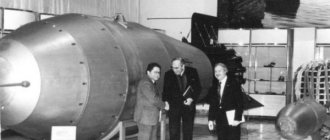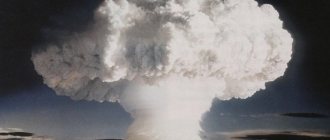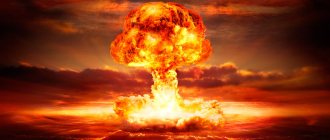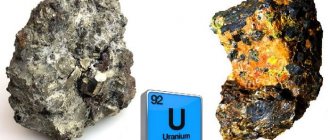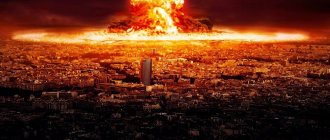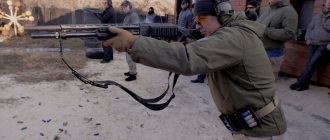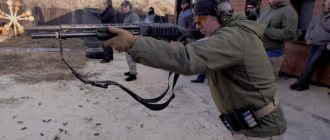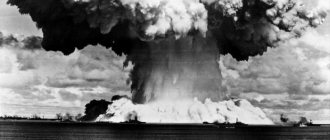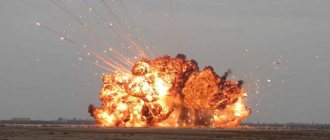Coal dust
The first test of a vacuum charge was carried out in 1943 by a group of German chemists led by Mario Zippermayr. The principle of operation of the device was suggested by accidents in flour mills and mines, where volumetric explosions often occur. That is why ordinary coal dust was used as an explosive. The fact is that by this time Germany was already experiencing a serious shortage of explosives, primarily TNT. However, this idea was not brought to actual production.
In fact, the term “vacuum bomb” is not technically correct. In reality, this is a classic thermobaric weapon in which fire spreads under high pressure. Like most explosives, it is a fuel-oxidizer premix. The difference is that in the first case, the explosion comes from a point source, and in the second, the flame front covers a significant volume. All this is accompanied by a powerful shock wave. For example, when a massive explosion occurred in an empty storage facility at an oil terminal in Hertfordshire (England) on December 11, 2005, people woke up 150 km from the epicenter to the sound of glass rattling in their windows.
Table 1. Values of the coefficient k for reducing an explosive to TNT
| BB | TNT | Tritonal | RDX | heating element | Ammonal | Powder | TNRS | Tetryl |
| k | 1.0 | 1.53 | 1.30 | 1.39 | 0.99 | 0.66 | 0.39 | 1.15 |
Expression (1) was compiled for an explosion in which the shock wave propagates in all directions from the explosion point unhindered, i.e. in the form of a sphere. Very often in practice, an explosion occurs on some surface, for example, on the ground. In this case, the shock wave propagates in the air in the form of a hemisphere.
For explosions on an absolutely solid surface, all the energy released during the explosion spreads within a hemisphere and, therefore, the value of the mass of the exploding substance seems to double (in certain cases we can talk about the addition of a direct and reflected wave).
For an explosion on a surface that is not absolutely solid, for example, on the ground, part of the energy is spent on the formation of a crater. This flow rate is taken into account using the coefficient ƞ, the values of which are given in Table 2. The less the underlying surface allows energy to be expended on the formation of a crater, the closer the value of the coefficient ƞ is to 1. Another limiting case corresponds to the situation when the underlying surface easily transmits the energy of the explosion, for example , with an explosion in the air. In this case, the coefficient value is 0.5.
Taking into account the above, the value of MT in the general case is determined by the formula:
Vietnam experience
Thermobaric weapons were first used in Vietnam to clear jungles, primarily for helipads. The effect was stunning. It was enough to drop three or four of these volumetric explosive devices, and the Iroquois helicopter could land in the most unexpected places for the partisans.
Essentially, these were 50-liter high-pressure cylinders, with a brake parachute that opened at a height of thirty meters. About five meters from the ground, the squib destroyed the shell, and a gas cloud formed under pressure, which exploded. At the same time, the substances and mixtures used in air-fuel bombs were not anything special. These were ordinary methane, propane, acetylene, ethylene oxide and propylene.
It soon became clear experimentally that thermobaric weapons have enormous destructive power in confined spaces, such as tunnels, caves, and bunkers, but are not suitable in windy weather, under water and at high altitudes. There were attempts to use large-caliber thermobaric shells in the Vietnam War, but they were not effective.
Thermobaric weapons: What are they and why were they banned?
The content of the article
What are thermobaric weapons?
The average person is much more familiar with the phenomenon of volumetric explosion and encounters it much more often than he thinks. More than once or twice in our country, flour mills, sugar processing plants, carpentry workshops, and mines exploded. In short, rooms in which a suspension (dust) of flammable substances or a mixture of flammable gas and air accumulates. And what about the familiar household gas explosions in apartments that destroy entire entrances and even houses? What about explosions of gas tanks and tanks during welding work?
These are all phenomena of a volumetric explosion. A mixture of oxygen (air) with a flammable substance is created, a spark, an explosion.
The fuel does not necessarily have to be gas, gasoline vapor, or coal dust. Ordinary very small sawdust (for example, from under a grinder), flour, sugar dust, when raised by a stream of air, explode no worse. The whole point here is the huge area of contact of the substance with oxygen. In this case, the combustion process involves a very large volume of substance at once and in a very short time (fractions of a second).
However, this does not mean at all that you can grind TNT into dust and the bomb is ready for a volumetric explosion. In conventional high explosives, the transfer of energy and the transformation of the substance into a large amount of compressed and highly heated products occurs according to slightly different laws, and for TNT, for example, on the contrary, the more dense and compressed it is, the better the detonation occurs. And if TNT is turned into dust, it will give no more effect than wood flour.
So, the principle of a volumetric explosion is clear and not at all complicated. It is necessary to create an aerosol cloud of a flammable substance (flammable gas, hydrocarbon fuel vapor, fine dust of any combustible substance) mixed with atmospheric air, apply fire (spark) to this cloud and a very powerful explosion will occur. Moreover, the consumption of the substance is several times less than what is needed for a high explosive for an explosion of the same power.
The question is how to create this cloud at the target and how to initiate the explosion, i.e. purely technical and design problems.
History of thermobaric weapons before their ban
For the first time, American ammunition designers began solving this issue around 1960. However, for a long time this work did not go beyond laboratories and individual test explosions.
Even then, it was established that when a bomb containing 10 gallons (approximately 32-33 liters) of ethylene oxide is detonated, a cloud of fuel-air mixture with a radius of 7.5 - 8.5 m and a height of up to 3 m is formed. After 125 milliseconds, this cloud is detonated by several detonators. The resulting shock wave has an excess pressure of 2,100,000 Pa along the front. For comparison, to create such pressure at a distance of 8 meters from a TNT charge requires about 200-250 kg. TNT. At a distance of 3-4 radii, i.e. at a distance of 22.5 -34 m, the pressure in the shock wave quickly decreases and is already about 100,000 Pa. To destroy an aircraft by a shock wave, a pressure of 70,000 - 90,000 Pa is required. Consequently, such a bomb, when exploded, is capable of completely disabling an airplane or helicopter in the parking lot within a radius of 30-40 m from the explosion site.
Ethylene oxide, propylene oxide, methane, propyl nitrate, MAPP (a mixture of methyl, acetylene, propadiene and propane) have been tested and found suitable for use as blast bomb explosives.
However, the American military became interested in volumetric explosion ammunition only during the Vietnam War, when it was necessary to quickly clear landing sites for helicopters in the jungle. The fact is that the Viet Cong very quickly noted the very high degree of dependence of the regular units of the US Army on the supply of ammunition, food and other material resources. As the Americans deepened into the jungle, it was enough to disrupt their supply and evacuation lines (which, in general, is not so difficult to do) to doom them to gradual death. The use of helicopters to transport supplies in the jungle was very difficult, and often completely impossible, due to the lack of open places suitable for landing. Clearing the jungle to land just one Iroquois helicopter required from 10 to 26 hours of work by an engineering platoon, while often in battle everything was decided in the first 1-2 hours.
For the first time, volumetric explosion bombs were used in Vietnam in the summer of 1969 specifically to clear the jungle. The effect exceeded all expectations. The Iroquois could carry 2-3 of these bombs (right in the cockpit). The explosion of one in any jungle created a completely suitable landing site.
Very soon the Americans began to use them to clear the jungle around strongholds and along communication routes. At the same time, their very strong impact on Viet Cong fighters was revealed. The fact is that the resulting cloud of atomized fuel obeys ordinary gas laws and flows into non-hermetically sealed structures, including underground shelters. Thus, the explosion occurs not only outside the structure, as with the explosion of conventional ammunition, but also inside the structure.
The first samples of volumetric explosion bombs were quite small in size and capacity (up to 10 gallons). After the release at a relatively low altitude (30-50 meters), the braking parachute opened, which ensured stabilization of the bomb and the rate of descent most favorable for the sequence of operation operations (explosion of the squib and opening of the bomb body, spraying of the fuel mixture, scattering of detonators, explosion of detonators). A 5-7 meter long cable with a weight was lowered from the nose of the bomb. A decrease in the tension of the cable when it touched the ground caused the start of operation.
Attempts to create ammunition in larger calibers at that time were unsuccessful due to technical difficulties. A workaround was found - cluster bombs. One cassette contained several volumetric explosion bombs of 32.6 kg caliber. These several bombs were distributed over a certain area, thereby increasing the size of the cloud.
The use of artillery turned out to be impractical due to the fact that even large-caliber projectiles could carry a relatively small amount of liquid explosives and most of the weight of the projectile fell on the thick walls of the projectile body.
An attempt was made to create ammunition for making passages in minefields. For this purpose, it was planned to use a 30-barrel MLRS “Zuni” (multiple launch rocket system). The shells were fired sequentially along the same course, but at different ranges. It was assumed that one salvo would be enough to gain passage through a minefield 100m deep. and 10-12m wide. However, excessive dispersion of projectiles buried this idea, although individual explosions showed a good response of pressure-action mine fuses to the shock wave of a volumetric explosion.
Gun ban and repeal
The further development of volumetric explosion munitions was influenced by the 1976 UN resolution that volumetric explosion munitions are “an inhumane means of warfare that causes excessive human suffering.” Although work on volumetric explosion ammunition was significantly slowed down, it continued in a number of countries.
Volumetric explosion ammunition was repeatedly used in various wars of the 80-90s.
So on August 6, 1982, during the war in Lebanon, an Israeli plane dropped such a bomb (American made) on an eight-story residential building. The explosion occurred in the immediate vicinity of the building at the 1-2 floor level. The building was completely destroyed. About 300 people died (mostly not in the building, but those close to the explosion site).
In August 1999, during the period of Chechnya’s aggression against Dagestan, a large-caliber volumetric explosion bomb was dropped on the Dagestan village of Tando, where a significant number of Chechen militants had accumulated. The invaders suffered huge losses. In the following days, the mere appearance of a single (precisely single) SU-25 attack aircraft over any populated area forced the militants to hastily leave the village. Even the slang term “Tando Effect” has appeared.
Around the second half of the eighties - the beginning of the nineties, many countries came to the conclusion about the high combat effectiveness of volumetric explosion ammunition and the inconsistency of the thesis “inhumane means of warfare that cause excessive suffering of people” (as if there could be humane methods of killing and it was possible to measure the degree of suffering of those killed or maimed people).
At the international exhibition of weapons, military equipment and ammunition Russian Expo Arms 2002, held July 9-13, 2002. at the test site of the Nizhne Tagil Institute for Metal Testing (NTIIM) village. Prospector of the Sverdlovsk region, two new samples of volumetric explosion ammunition (the second name is “thermobaric ammunition”), the ODAB-500PMV and 300mm aerial bomb, were presented and offered for sale. 9M55S rocket for the Smerch MLRS.
Fuel-Air Explosion Aircraft Bomb ODAB-500PMV
| Performance characteristics of the ODAB-500PMV bomb | |
| Diameter | 50 cm |
| Length | 238 cm |
| Stabilizer span | 68.5 cm |
| Weight | 525 kg |
| Charge mass | 193 kg |
| Explosive recipe | ZHVV-14 |
Used from airplanes and helicopters. Conditions of use:
- for airplanes, altitude is 200-12000 m at a speed of 500-1500 km/h.
- for helicopters, an altitude of at least 1200 m at a speed of more than 50 km/h.
It is easy to guess that the distance of a helicopter from a bomb at the moment of its explosion is less than 1200 meters is deadly.
After separation from the carrier at an altitude of 30-50 m, the braking parachute located in the tail of the bomb opens and the radio altimeter is activated. At a height of 7-9 meters, an explosion of a conventional explosive charge occurs (highlighted in light orange in the figure). In this case, the thin-walled body of the bomb is destroyed and the liquid explosive sublimes (the recipe is not given). After 100-140 milliseconds, the initiating denator, located in a capsule attached to the parachute, explodes and the fuel-air mixture explodes.
300mm. 9M55S rocket with thermobaric warhead
This projectile is used by the Smerch multiple launch rocket system (MLRS).
| Performance characteristics of the 9M55S projectile | |
| Projectile type | reactive, controlled |
| Artillery system that uses projectiles | MLRS 9K58 "Smerch" |
| Projectile caliber | 300 mm. |
| Projectile length | 760 cm. |
| Projectile mass | 800 kg. |
| Warhead weight | 280 kg. |
| Maximum flight range | 70km. |
| Minimum firing range | 20km. |
| Warhead type | monoblock thermobaric |
| Dispersion of projectiles by range and course | no more than 0.21% |
Although the Smerch MLRS allows you to fire the entire ammunition load (12 shells) in 20 seconds, shells with a thermobaric warhead are fired either as single shells or at time intervals that ensure the explosion of the previous shell before the next shell approaches the explosion zone.
When a projectile approaches a target on the downward part of its trajectory, the projectile is divided into three parts - the warhead, the warhead, and the propulsion part. At an altitude of 60-70m. The braking parachute opens and the radio altimeter is activated. Then everything happens the same as with an aerial bomb.
conclusions
The question may arise: why have they not yet abandoned conventional explosives, all conventional shells, aerial bombs, and missiles, if volumetric explosion ammunition is 5-8 times stronger than conventional explosives in terms of shock wave strength and has colossal lethality?
- Firstly, volumetric explosion ammunition has only one damaging factor - a shock wave. They do not and cannot have a fragmentation, cumulative effect on a target.
- Secondly, the brisance (i.e. the ability to crush, destroy an obstacle) of a cloud of fuel-air mixture is very low, because here it still has an explosion of the “combustion” type, while in many cases an explosion of the “detonation” type is required and the ability of the explosive to crush the body of the projectile, the element being destroyed, etc. Let me explain - during an explosion of the “detonation” type, the object in the explosion zone is destroyed, crushed into parts because the rate of formation of explosion products is very high. In a “combustion” type explosion, the object in the explosion zone, due to the fact that the formation of explosion products occurs more slowly, is not destroyed, but is thrown away. Its destruction in this case is secondary, i.e. occurs during the process of being thrown away due to collision with other objects, the ground, etc.
- Thirdly, a volumetric explosion requires a large free volume and free oxygen, which is not required for the explosion of conventional explosives (it is contained in the explosive itself in a bound form). Those. The phenomenon of a volumetric explosion is impossible in airless space, in water, in soil.
- Fourthly, the operation of volumetric explosion ammunition is greatly influenced by weather conditions. In strong winds or heavy rain, the fuel-air cloud either does not form at all or is greatly dispersed.
- Fifthly, it is impossible and impractical to create small-caliber volumetric explosion ammunition (less than 100 kg bombs and less than 220 mm shells).
There are many more reasons why volumetric explosion ammunition cannot replace conventional ammunition and why the use of the volumetric explosion phenomenon is limited.
Thus, these ammunition are not a universal means and the extent of their use depends on what type of ammunition or weapon is appropriate and most effective in each specific case.
Source
Thermobaric death
On February 1, 2000, immediately after the next test of a thermobaric bomb, Human Rights Watch, a CIA expert, described its effect as follows: “The direction of the volumetric explosion is unique and extremely life-threatening. First, people in the affected area are affected by high pressure of the burning mixture, and then by a vacuum, actually a vacuum, tearing the lungs. All this is accompanied by severe burns, including internal ones, since many manage to inhale the fuel-oxidative premix.”
However, with the light hand of journalists, this weapon was called a vacuum bomb. Interestingly, in the 90s of the last century, some experts believed that people who died from a “vacuum bomb” seemed to be in space. They say that as a result of the explosion, oxygen instantly burned out, and for some time an absolute vacuum was formed. Thus, military expert Terry Garder from Jane magazine reported on the use of a “vacuum bomb” by Russian troops against Chechen militants in the area of the village of Semashko. His report said that those killed had no external injuries and died from ruptured lungs.
About correct use
Before use, the soldier must straighten the safety tendrils, and then take the grenade so that his hand completely fixes the clamping lever to the body.
Just before throwing (!) you need to pull the pin. You can keep the “lemon” in this position for an indefinitely long time, since when the lever is compressed, the capsule is not initiated, and therefore an explosion will not occur. Once a target is selected, you should vigorously throw a grenade at it. At this moment the lever will turn, releasing the firing pin, and fly off to the side. The firing pin initiates the primer (by puncturing it), and after three to four seconds an explosion occurs.
Do you remember how in films they repeatedly showed an episode when a desperate sailor (soldier, revolutionary, partisan, etc.) in a last, desperate jerk pulls out the pin with his teeth? If you decide to repeat this trick, make sure you have a good dentist in advance, since you will 100% have to change your front teeth. Even with your hand, if the fixing antennae are not straightened, such a feat can only be accomplished by so many teeth... In a word, don’t even think about tearing out the pin in this way!
Second after the atomic bomb
Just seven years later, on September 11, 2007, the thermobaric bomb was talked about as the most powerful non-nuclear weapon. “The test results of the created aircraft munition showed that its effectiveness and capabilities are comparable to nuclear weapons,” said the former head of the GOU, Colonel General Alexander Rukshin. We were talking about the most destructive innovative thermobaric weapon in the world.
The new Russian aircraft munition turned out to be four times more powerful than the largest American vacuum bomb. Pentagon experts immediately stated that the Russian data was exaggerated by at least twofold. And the press secretary of US President George W. Bush, Dana Perino, at a briefing on September 18, 2007, when asked how the Americans would respond to the Russian attack, said that this was the first time she had heard about it.
Meanwhile, John Pike from the GlobalSecurity analytical center agrees with the declared capacity that Alexander Rukshin spoke about. He wrote: “Russian military and scientists were pioneers in the development and use of thermobaric weapons. This is a new history of weapons." If nuclear weapons are a priori a deterrent due to the possibility of radioactive contamination, then super-powerful thermobaric bombs, according to him, will most likely be used by “hot heads” of generals from different countries.
How does the F-1 grenade fuse work?
In the normal state, the striker is loaded with a mainspring and secured with the fork of the safety lever, which is associated with its shank. The upper end of the mainspring rests against the chamfer of the guide washer, and the lower end rests against the chamfer of the firing pin washer. Fixation of the safety lever is ensured by a safety pin inserted into the holes of the housing and lever.
After removing the safety pin, the fighter must hold the lever with his hand. When thrown, the spring forces the lever to rotate, resulting in the release of the firing pin. The mainspring pushes it, and it punctures the body of the igniter primer, which causes the moderator to ignite. After the latter burns out, the fire reaches the detonator charge, which causes the F1 grenade to explode.
External differences
A characteristic feature is a ribbed body, cast from a special type of cast iron. It is divided into exactly 32 segments. Theoretically, this should mean that during an explosion the same 32 fragments are formed, but in practice this does not always happen. Together with the fuse, the lemon grenade weighs as much as 0.6 kg. The role is played by TNT. Weight - 60 grams. The fuse is characterized by its versatility, as it can be used simultaneously with the RGD-5. Its index is UZRGM.
It should be remembered that combat grenades are painted strictly green, which can vary from khaki to dark olive. The training version is black; in this case, there are two white stripes on the surface of the “projectile”. In addition, the training “limon” grenade has a hole in the lower part
Important! The combat fuse does not have any indicating coloring
The training grenade is different in that its pin and the entire lower part of the pressure lever are painted scarlet. Since you can make a training “limon” (grenade) from a combat one by unscrewing the fuse and “frying” the body over a fire (the explosive will simply burn out, without an explosion), then when making an “ersatz” you don’t need to forget about this feature. Otherwise, someone might have a heart attack during a training exercise.
The history of the creation of the Russian F-1 grenade
The following systems, which were in service at the beginning of the last century, became the basis for the development of the first version of the Russian grenade:
- French F-1 hand grenade;
- English grenade of the Lemon system.
This is precisely what explains the markings of that grenade, which is used in the Russian army to this day, as well as its widespread nickname “Limonka”.
In the early Russian version, a far from perfect fuse of the Koveshnikov system was installed, the explosion delay time of which was 6 seconds. This defensive grenade was first modernized in 1939. Two years later, in 1941, a Vinzeni system fuse was installed in it, which delayed the grenade explosion by 3.5 - 4.5 seconds. Later, this element began to be called a unified fuse for hand grenades (UZRG), which until the eighties of the last century was a single fuse for all fragmentation hand grenades being developed. Its characteristics have satisfied and continue to meet the requirements of modern close combat.
Main characteristics
This grenade belongs to the class of hand-held defensive weapons. Simply put, it is intended to destroy enemy personnel with shrapnel due to its use by a soldier manually, without the use of any auxiliary means for throwing. In a word, a classic grenade, the operating principle of which has not changed since the days of the glorious bombardier Pyotr Alekseevich. The deceleration time is from 3.2 to 4.2 seconds, quite “blurry”.
What is the difference between the defensive variety? This term means that during an explosion a fairly large number of massive fragments are formed, scattering over a distance noticeably greater than that for a throw. After throwing such a grenade, a soldier must jump into a fairly reliable shelter. Otherwise, there is a high probability of being hit by his own weapons. This is the kind of grenade they call a “lemon”.
Where did the “limonka” come from on Russian soil?
Most likely, the prototype was the Mils grenade from the First World War. At that time it was the most advanced weapon in its class. This assumption is probably not without a grain of truth, since the shape and design principle of the fragmentation jacket are surprisingly similar. However, there is another point of view.
F. Leonidov believes that the immediate model for assembly was the French F-1 (!), which was put into service in 1915 and... the English Lemon grenade (one of the versions is why the F-1 grenade is called “lemon”). But no one can prove whether this is really so.
In principle, this is not so important, because the design of the fuse is originally domestic, and the high technology of production is a tribute to the Soviet weapons tradition. Both English and French samples from WWII are much more difficult to manufacture and more expensive
Cons of lemons
Firstly, weight. As much as 0.6 kg! In combat conditions this is a very significant mass. Secondly, “blurred” fuse action: from 3.2 to 4.2 s. Moreover, in practice there are constantly samples that can explode in both a shorter and longer time. In one part of Transbaikalia, this circumstance almost led to tragedy when a grenade exploded after eight seconds!
At that time, the soldier had already leaned out from behind the cover, and only by a lucky coincidence he was not chopped into shrapnel. In addition, in combat conditions, the prolonged action of the fuse can lead to the fact that a particularly “nimble” enemy will simply throw away the “gift” that has flown to him.
Thirdly, there is no grenade option that would explode immediately after contact with the target. These are the so-called mountain models. In Afghanistan, this has repeatedly led to tragedies when a thrown projectile bounced off a rock and flew back. All these shortcomings were absent in the RGN. But they were much more expensive and more difficult to produce, and their release occurred during the collapse of the USSR. So the same “efka” remained on guard.
The F1 lemon grenade, having many positive qualities, will in any case be in service with our army for many years to come.
Advantages of F1
Why is it that this weapon, which actually appeared a hundred years ago, is still actively used not only in our army, but also in the armed forces of other states of the former USSR? The most important circumstances are simplicity, manufacturability and low cost of production. The process of the latter was extremely simple: the body was cast, molten TNT was placed in it, cooled...
And the grenade was ready! Compare this with the production of the same Russian Geographical Society, when steel, plastic, and other materials are used. “Limonki” could be produced by any enterprise that had at least some kind of foundry.
In addition, the weight of the grenade allows it to be used effectively in urban environments: if thrown with sufficient energy, it will easily fly through glass, branches, and other obstacles. In addition, the detonation does not depend in any way on the force with which the F-1 collides with the surface. It can fall on a tree, rock, steel, swamp or river, but it will still explode (usually).
In addition, the F-1 lemon grenade is quite powerful and lethal. What else does the military need? Oddly enough, a lot. These grenades also have disadvantages.
Parameters of the air shock wave of a volumetric detonating explosion
The main parameters of the air shock, which determine its damaging effect on humans and destruction of material objects, are: excess pressure at the front of the air shock, the impulse of the positive compression phase, the duration of the compression phase and the effective specific energy of the air shock. The profiles of changes in the main parameters of explosive explosives during the explosion of volumetric detonating systems differ from similar dependencies for the case of condensed explosives (CHE), described by the formulas of M.A. Sadovsky and GOST B-25.801-83. The dependences of the air shock parameters for the case of a ground explosion of volumetric detonating systems were obtained based on the method of energy similarity of explosion and dimensional theory, the numerical values of the coefficients in the equations were obtained by regression analysis of numerous experimental data from domestic and foreign researchers, in which the mass of the fuel charge varied within the range of 3 up to 1000 kg. The dependences of the main parameters of the air shock wave (excess pressure at the front, pressure pulse of the compression phase and duration of the compression phase) on distance were obtained. These expressions are constructed in the form of Sachs transformations and have the following form:
Where:
ΔPф – excess pressure at the front of the air shock wave, Pa; P0 – atmospheric pressure, Pa; a0 – speed of sound in an undisturbed atmosphere (a0 = 340 m/s), m/s; E – total explosion energy of the fuel assembly cloud (E=MgQexp), J; Mg – mass of fuel, kg; Qexp – specific heat of explosion of fuel, J/kg; τ+ – duration of the compression phase, s; I+ – compression phase pressure impulse, Pa.s; R – distance from the cloud center, m.
The values of the effective specific energy of the air shock wave (in kJ/m2) are calculated using equation (5) based on the value of excess pressure at the air shock wave front (in g atm) and the duration of the compression phase (in ms) with an average relative error not exceeding 1% (compared to with the results of numerical integration):
The damage to a person is calculated using the reduced area of damage. Taking the assumption that at points equidistant from the center of the explosion, the damaging characteristics of the air blast have the same parameters, and the reduced affected area has the shape of a circle, its value can be calculated using the formula
Where:
R0 – radius from the center of the explosion, where the probability of hitting the target is 1 m; n – number of points dividing the remaining affected area, pcs.; Ri+1 – radius from the center of the explosion to the next point, m; Pi+1, Pi – marginal probabilities of defeat.
The values of the air shock wave parameters (excess pressure at the air shock wave front, impulse of the compression phase, duration of the compression phase and specific effective energy) during the explosion of a cloud of gas-propane gas (1000 tons of propane) for various distances are given in Table. 4.
Graphs of the dependences of the parameters of the air shock wave (excess pressure at the air shock wave front, impulse of the compression phase, duration of the compression phase and specific effective energy) during the explosion of a cloud of gas-propane gas (1000 tons of propane) on the distance to the center of the cloud are shown in Fig. 2.
We calculate the areas of the reduced damage zones of a volumetric explosion per person for various types of damage and degrees of cover (Table 5).
On the other hand, the training manual provides a classic scheme for comparing the power of the explosion of hemispherical charges on the surface of the earth: HVV (TNT) and a hemispherical cloud of HPVS (propane), leading to a practical doubling of the power due to the reflection of the VUV. Considering that propane with a molecular weight of 44 c.u., compared to air (at least 29 c.u.), during natural evaporation, as a rule, will not rise to a height of more than 150 m, as given in the solution, then we can assume that the height of the propane cloud will not exceed 5-6 m, which will make the distribution area for a volume of PGVA 6.316 - 106 m3 about 1.148 - 106 m2.
Thus, over an area of \u200b\u200bone km2, when an explosive explosive is initiated or a random spark with the required initiation energy, a volumetric detonating explosion can occur with an excess pressure at the explosive front of at least 12-15 atm, which will lead to 100% injury to people with a degree not lower than lethal and heavy, which can amount to an explosion power of at least 50 kilotons in TNT equivalent (in terms of the shock wave, the effect is comparable to the explosion of a nuclear charge).
F-1 grenade device
A hand grenade consists of:
- metal case;
- UZRGM fuse;
- explosive charge.
The body is the location of the trigger mechanism, the firing pin of which is guided by a washer fixed inside the grenade. In addition, an igniter equipped with a threaded bushing is screwed into the body.
The design of the trigger mechanism assumes the presence of:
- safety lever;
- safety pin with ring;
- striker with mainspring.
The detonator is in a metal case, and its device includes:
- detonator capsule;
- igniter primer;
- powder retarder.
Estimation of shock wave parameters during the explosion of gas-air mixtures
Shock wave parameters at distances R o
During explosions of gas-air mixtures, the parameters inside the gas cloud can vary over a very wide range depending on the conditions of the explosion, the concentration of the flammable component and the nature of the explosive combustion, which are practically impossible to take into account when predicting explosions, especially in the open air. Therefore, calculations are usually carried out for the worst case, in which the destructive consequences of the explosion are greatest.
This worst case is the detonation combustion of a mixture of stoichiometric composition. The speed of propagation of the detonation combustion process inside the cloud is very high and exceeds the speed of sound. The pressure inside the cloud during the explosion is generally not constant. However, to carry out an approximate assessment of the parameters of the explosion, we can conditionally assume that the cloud has the shape of a hemisphere with a center on the surface of the earth, the explosion of the hot water supply occurs instantly and the pressure during the explosion is the same and constant at all points located inside the cloud.
For most carbon-hydrogen-containing gas mixtures of stoichiometric composition, it can be assumed that the pressure inside the gas cloud is 1700 kPa. To carry out more accurate calculations, the technical literature provides calculation relationships that allow one to calculate the rate of detonation combustion, the time of complete detonation of the cloud, the pressure in the detonation wave, etc.
Shock wave parameters at distances R > ro
Formulas for determining the values of the parameters of the shock wave at distances exceeding the radius of the hemisphere of the gas cloud in the surrounding air were obtained by approximating the numerical solution to the problem of detonation of a propane-air mixture, carried out by B. E. Gelfand. The solution was obtained by integrating a system of nonstationary gas dynamics equations in spherical coordinates in Lagrange variables and allows obtaining results that are in satisfactory agreement with experimental data for flammable mixtures of various hydrocarbons with air.
Maximum excess pressure at the shock wave front (kPa):

